
The Vietnamese people today celebrated the 30th anniversary of their


glorious victory over the American imperialists as you can see from this news item from Al Jazeera.







These days, images from Ho Chi Minh City, formerly known as Saigon and other parts of Vietnam are not very different from other Asian and Third World regions:

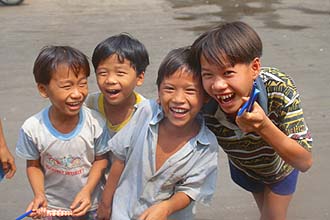
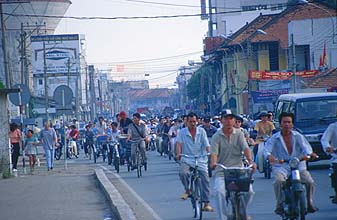
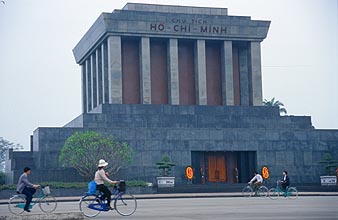
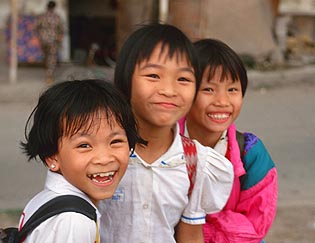
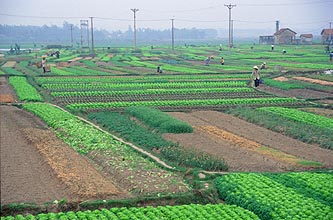
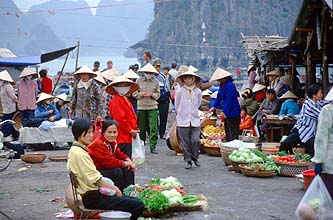
%20Pass2.jpg)
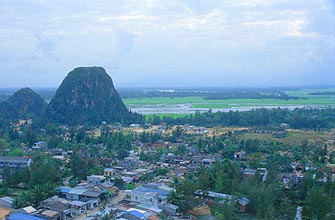
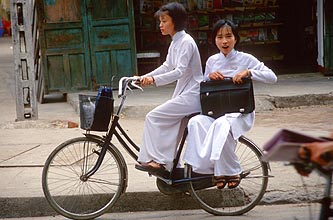
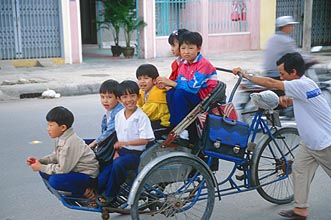
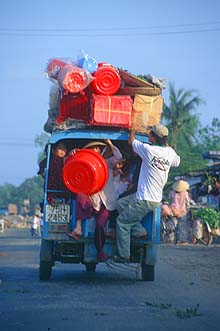
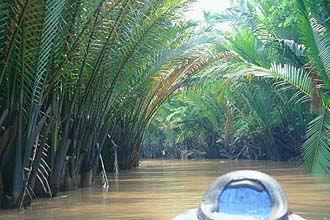
Yet away from those laughing children, green fields and crowded minibuses lurks the enduring macabre legacy of the United States criminal devastation of the people, the environment, the economy and the resources of Vietnam.
For starters, Agent Orange has practically become synonmous with the the American Imperialist War against the Vietnamese people(not surprisingly the gringos call it the "Vietnam War" as if it was Vietnam which attacked the United States of America).
If you know nothing about the terrible genocidal side-effects of Agent Orange, click here.
Guess what happened on March 10, 2005?
Here is how the Vietnamese government reacted to that negative verdict.
Check out this technical article from the New Scientist.
My Lai has become a byword for war atrocities against women, children and the elderly as you can see from this "very unfriendly" assessment of the US war effort in Vietnam.
Here is another account.
Pictures like these


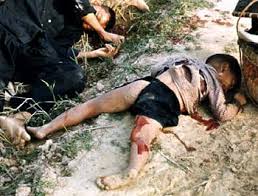












RARELY LIE, OK?

Noam Chomsky, the well-known and respected US linguist and political commentator gave a very candid interview where he provided a lot of critical insight into the US aggression against the Vietnamese people. You can read a transcript of that interview by clicking on this link.
Another legacy of Vietnam is the plethora of dangerous and deadly mines that were left behind long after the conflict ended.
The United States has never accepted its military defeat on April 30th, 1975. After the war, it continued its aggression against Vietnam by other means including hostile economic and diplomatic policies as you can see from this essay.
While it is true, like Le Duan said, it was primarily the collective strength and dedication of millions (especially those militant, politically conscious revolutionary cadres) of Vietnamese patriots who came together to defeat in succession THREE imperialist powers- Japan, France and the United States, without its brilliant leaders like Ho Chi Minh, Le Duan Pham Van Dong and Vo Nguyen Giap, their history may perhaps turned out a bit differently.
Who is the most famous, who is the most celebrated and who is considered the most brilliant general of the 20th Century?
General de Gaulle?
General Eisenhower?
General Shwartzkopf?
General Montgomery of El Alamein?
General Colin Powell?
Without HESITATION, I say NONE of the ABOVE.
Try General Vo Nguyen Giap.
Who is he?
Well, first take a look:























General Vo Nguyen Giap
Now find out more about the man by reading this brief biographical outline.
Believe it or not, the General is still alive and well. His mind at the tender young age of 93, is still sharper than the newest razor.
Here is the living legend pictured on Friday, April 29th, 2005 at a function to commemorate that famous victory:

And now, saving the best for the last, here is General Vo Nguyen Giap in an article he wrote yesterday, April 29th, 2005:
By General Vo Nguyen Giap
Years will go by, but the great victory of our people in the war against the US for our national salvation will forever be entered into the annals of our nation as one of the most brilliant feats of arms and one of the brightest manifestations of the ultimate victory of revolutionary heroism and human wisdom in world history; a great exploit of the 20th century and an event of international importance that profoundly defines our times.
In her history of repelling foreign invasion, the nation of Viet Nam has faced extreme challenges: a thousand years of northern feudal domination; a thousand years of protecting national independence from northern feudal lords, including three instances of resistance against Yuan invaders who constituted the strongest invasion force of the 13th century; nearly a hundred years of struggle against colonialist domination and invasion by French imperialists; and 21 years of resistance against American imperialist invasion.
The war against the US was the greatest and fiercest challenge of our nation.
We were forced to confront the richest, most powerful, cruellest and most insidiously aggressive imperialist. The war lasted through the administrations of five US presidents and faced us with an inequality of force more exaggerated than any in our nation's history of anti-aggression; an inequality both in terms of mode of production and military-economic strength.
Viet Nam became the focus of a fierce struggle between revolutionary and counter-revolutionary forces in the world, a crucible testing the opposing strengths of the progressive and the reactionary and of justice and injustice in mankind's aspiration for peace, national independence, democracy and social progress.
President Ho Chi Minh noticed the dark seeds of the US plot of interference at the end of the first Indochina war against France. In order to secure peace, he sent 11 letters to US President Harry S Truman. Even when the smoke of guns had yet to clear after the Battle of Dien Bien Phu, he warned "The victory is great, but it is just the beginning... We still have to fight the Americans!"
In July 1954, at the 6th Meeting of the Central Committee of the Viet Nam Workers Party (now the Communist Party of Viet Nam), just a few days before the conclusion of the Geneva Agreement, it was explicitly noted, "US imperialists are becoming the primary and direct enemy of the people of Indochina. "
Inheriting the fruits of the victorious resistance against the French, our nation entered into the war of resistance against the US with a liberated North Viet Nam linked with other socialist countries and evolving into a great base for a front in the South. The leadership of the Party and its army had been seasoned in guiding the resistance and the revolutionary war. Our people and army throughout the country had overcome extreme challenges and matured many times over during nine years of prolonged war against the French.
President Ho and our Party had rightly identified the revolutionary line in this new stage of national development: to conduct simultaneously two revolutionary strategies in two regions for the common goals of fighting the US for national salvation, defending the North, and reunifying the country. They also clearly pointed out the strategic relationship between the North and the South: building socialism in the North would create the strength to liberate the South, promoting the revolutionary struggle in the South would help the South liberate itself and protect the North. The North played the leading role, but the South had a directly decisive role in the cause of democratic national revolution for the whole country. This was the will of all the sons and daughters of Viet Nam: "Viet Nam is one country, one nation. Rivers may run dry, mountains may crumble, but this truth will never change."
Our Party had combined and brought into full play the strength of the nation and the strength of the era, building up a fighting alliance of the people from the three Indochinese countries, forging solidarity with other revolutionary movements in the world, including the Soviet Union, China and our other socialist brothers, to form and develop a vast front of peace and justice-loving mankind in the world - including American people who supported Viet Nam against the American government's war of aggression.
Based on the Vietnamese tradition of an indomitable spirit and will to defeat all foreign invaders, President Ho and our Party educated our entire population and army from North to South with a "determination to defeat the American aggressors". Determined to fight and knowing how to fight, being brave and intelligent, revolutionary heroism and creativity proved to be the stuff and wisdom of Viet Nam, the vehemence and vitality of a nation needed to overcome this historic challenge.
Determined to fight and knowing how to fight was a highly creative process involving many facets: the creativity of the leadership and of the masses in fighting a real war, discovering and mastering the rules of revolution, knowing the enemy and ourselves as well; assessing correctly the true balance of power, knowing how to limit the strong points and dig deep into the weakest points of the enemy, gathering forces to deliver a decisive blow and favourably alter the complexion of the war, persevering and gaining little by little to finally achieve total victory.
The US imperialists had mobilised into the war of aggression in Viet Nam a huge amount of ammunition and technology such as had never before been seen on such a narrow stretch of land, using all of the most modern and barbarous weapons short of the nuclear bomb itself. They had even brought the number of US troops in South Viet Nam to more than half a million to fight together with a large naval force, a strategic and tactical air force, and over 75,000 troops from American allies and more than a million troops from the Sai Gon regime, making up a record number of troops for a local war. The US administration tried all political, military and diplomatic strategies and tactics, resorting to the most brutal forms of warfare, from blockades to all around terrorism, economic destruction, eradication of villages and towns, the murder of civilians and destruction of the environment. The White House and the Pentagon dispatched their most talented strategists and generals to fight a mind game with us….
The strategic campaign in the spring of 1975 marked a new development in the people's war, a test in key battles of our organisational and command art and skill, especially the art to conduct war in its last stages. After completing strategic preparations in terms of position and strength in both the North and the South, the campaign to liberate the Tay Nguyen began with the victory at Buon Me Thuot, a campaign that drastically altered the complexion of the war.
Smart at both grasping an opportunity and proactively creating one, the Political Bureau and the Party Central Military Committee continuously updated our strategy in response to rapid changes on the battlefields, shortening our strategic plan to liberate the South from two years to one year when the opportunity presented itself. After the success of the Hue-Da Nang campaign, we came to the conclusion that we could liberate the South before the rainy season of 1975.
With the impetus of "lightening speed and more lightening speed, daring and more daring," the historic Ho Chi'Minh Campaign was conducted with a determination to win total victory. After 55 days and nights the general offensive and popular uprising, thanks to our overwhelming political and military strength, used three key strategic blows in combination with attacks and uprisings in the Cuu Long (Mekong) Delta to put out of action over a million troops of the Sai Gon regime. The liberation flag flew over Doc Lap (Independence) Palace. The Sai Gon regime collapsed. The last American aggressors were forced to flee our country.
The victory in the war against US aggression was a victory of leadership and command at the macro-level of our Political Bureau, the Party Central Military Committee, the Party Central Committee for the South, the Headquarters of the Liberation Army, the front commands, the strategic agencies, the party committees of the zones, the battlefield and campaign commands, and the Truong Son Command. It was also the victory of the undaunted and creative fighting of our entire armed forces on all battlefields. It is not the victory of any individual command or unit. The victory is the outcome of our entire nation's boundless sacrifice and unmatched endeavour in the fierce and prolonged competition of mind and strength between the people of Viet Nam and US imperialism.
How could the people of Viet Nam, without a single inch of iron in their hands, stand up to and break the chains of slavery, defeating two major imperialist powers in mismatched wars to regain their lands and liberate their nation and society?
To find the answer to this question, it is necessary to look back into the depths of thousands of years of history, to study the national culture and the traditions and military heritage of the Vietnamese people, as well as the revolutionary trend of Viet Nam under the leadership of the Party.
It is a rare thing in history indeed that the tribes of an ancient people, such as the early Vietnamese, developed a philosophy of life and a national culture with patriotism at its core, an unyielding will to struggle against and master nature and society. They united into a single nation-state to combat calamity and foreign aggression. It was thanks to these cultural attributes that, in more than 1,000 years of Northern feudal domination, our nation was not assimilated but stood up to regain independence. When the first progenitor of our national rebirth, the hero Ngo Quyen, defeated South Han troops on the Bach Dang River, an era of 1,000 years of national independence was opened. Throughout those thousand years, our nation defeated all other invaders, from the Sung and Yuan to the Ming and Qing who were much stronger than we. Notably, in the 13th century, our nation thrice defeated the Yuan army, the strongest army of the time and one which had conquered vast territories from Asia to Europe.
Every time an enemy tried to touch our country, "king and subjects in one heart, brothers in harmony," the whole country would join in strength to repel the invaders. From the Hich tuong si (Call for Officers) and Di chuc Canh Ty (Testament in the Year of Canh Ty (1420)) to the Binh Ngo dai cao (Proclamation of Victory Over the Enemy), a Vietnamese military doctrine came into being that "all of the people are warriors", that we can "oppose our weak forces to much stronger ones," and "a few troops defeat great armies." The doctrine fed struggles for national sovereignty with ideals that traveled beyond their time, like "Confront barbarity with justice, fight truculence with humanity" and "Extinguish forever the fire of war to bring about an eternal peace".
In the Ho Chi Minh era, there was natural evolution of these ideals from previous historical periods: national liberation goes hand-in-hand with social liberation, bringing freedom, prosperity and happiness to all of the people. The 1945 August Revolution and the two wars of resistance against the French and American aggressors were only the initial uprising and revolutionary wars. They were truly for the people and by the people. That revolution helped unleash the enormous moral and physical strength of the people.
On the basis of the determination to fight and win in the spirit of "nothing is more precious than freedom and independence," the fundamental philosophy and military doctrine in the Ho Chi Minh era directed us to conduct a resistance of all the people in which the entire population and nation took part in the struggle against the enemy. In his instruction to found the Proselytizing Brigade for the Liberation of Viet Nam, Uncle Ho wrote: "Ours being a national war of resistance by all the people, we must mobilise and arm all the people." He called for a nationwide resistance against the French colonialists: "Men and women, old and young, regardless of religious creed, political affiliation or ethnicity, all Vietnamese must stand up to fight the French colonialists and save the Motherland." In the war against the US aggressors, he confirmed: "Our resistance is one by all the people and is truly a people's war. Thirty-one million comrades and patriots in both the South and the North, old and young, male and female, must become 31 million heroic soldiers to annihilate the Americans and save the country". He highlighted the policy of national solidarity with the motto: "Unity, unity, great unity; success, success, great success".
We have inherited and developed our ancestors' traditional art of combating the enemy by "opposing our weak forces to much stronger ones" and inventing a series of intelligent methods of combat for our armed forces, for each of the army services and even each soldier, bringing together the determination to win and the wisdom to defeat all strategies, tactics and modern technology of an aggression force that was many times stronger than us.
However, at times in the war against the US aggressors, not yet firmly grasping the Party's military lines' and Uncle Ho's military thought, and being overhasty and subjective and unaware of reality, we suffered losses here and there, considerably limiting the scope of our victory.
During the initial stage of the war, many military cadres at the battlefields misapprehended the relationship between guerrilla warfare and regular warfare, placing importance only on political struggle and paramilitary forces and belittling the building of the regular army. Our Party has never applied a purely military doctrine and, at the same time, never limits armed struggle merely to guerrilla warfare. To confront the enormous material superiority of our opponents, we had to develop a regular army, from companies and battalions to divisions and army corps, in order to be able to deal decisive blows and annihilate the enemy on the battlefield. We expended enormous efforts to overcome losses caused by enemy strikes, and we determined to use motor vehicles along transport routes in the Truong Son Range in order to meet the strategic demands of battlefields in the South.
Some engaged in wishful thinking without firmly grasping the rules of revolutionary uprisings and warfare, and there emerged a subjective view advocating a general uprising that would have exposed completely the revolutionary bases of the people right at a time when there were a million US and Sai Gon troops and their allies on the battlefield. The extension of attacks on the townships and delay in shifting activities to rural areas during the 1968 Tet offensive ended up causing tremendous losses in terms of the revolution's position and strength.
The flawed application of the idea of revolutionary offense during the war was yet another costly lesson paid for in blood and bone. The strategic thought of revolutionary war is offensive, but tactics can be both offensive and defensive in terms of strategy, campaign and combat. The negation of the defensive, or even considering it as counter-revolutionary, led to many casualties in a number of battles.
Through the process of 30 years of war, the Vietnamese military doctrine always moved closer to revolutionary goals basing itself on the concrete reality of the war to define our rules of action. On the foundation and strength of the people's war, we took the initiative on the battlefield in all circumstances, forcing the enemy to passively defend against our strategies and methods of combat. The enemy wanted a lightening-quick war but had to fight a prolonged one. They wanted to make a war with a frontline but instead had to fight rivals all around them. They wanted to concentrate their forces but had to stretch themselves out due to our people's war. All their strategic calculations proved wrong. The more they tried, the more they became bogged down and impotent, leading to the final and unavoidable defeat on the battlefields of Viet Nam.
In the early 21st century, the complexion of the world has undergone profound change. In spite of a desire for and trend towards a world of peace and equality for the majority of nations and progressive mankind, certain superpowers and bellicose forces, as well as international military industrial corporations, are planning to establish a new world order, a comprehensive globalisation which they control, while waging wars of aggression, exciting secessionism, and instigating religious and ethnic conflicts, disturbances and violence in order to serve their goals of world hegemony and pulling the world into an unprecedented hi-tech arms race. The world security environment is in a time of unpredictable changes.
Correctly assessing changes in the situation to adapt to the development and progress of modem warfare in order to build and perfect Vietnamese military doctrine in the new era, we are fully confident of our ability to protect the independence, sovereignty and territorial integrity of the country, standing ready to defeat any aggressor however technically advanced they may be.
The victory day of April 30, 1975, has entered history as a complete end of the 10,000-day war. The Vietnamese nation, a nation that always desires peace, had to bear 30 years of sacrifice and hardship. With the three vermilion milestones of the August 1945 General Uprising, Dien Bien Phu, and the 1975 Spring Victory, our nation has gloriously completed the cause of national salvation. The country will never again see the shade of an enemy on our land, and our Motherland has become fully unified.
On the global scale, for the first time in the history of the struggle of small and weak nations, a nation that was a semi-feudal colony had stood up to liberate herself and conclusively defeat two imperialist powers mainly by her own strength. The words "Viet Nam - Ho Chi Minh" have entered into the vocabularies of many nations to mean, ",There is nothing more precious than independence and freedom," symbolising human conscience and dignity. Our people's victory was also the victory of peace- and justice-loving progressive people around the world.
Our victory asserts a truth of the time: "Any country, however strong it may be, if desiring to impose its will on other nations, will ultimately fail". Dien Bien Phu and the end of the war in the spring of 1975 were the turning points that history reserved for those wars of aggression.
After the celebration of 30 years of the victory in the war against the US aggressors, we are celebrating the 60th anniversary of the establishment of the Democratic Republic of Viet Nam (September 2,1945) with profound changes taking place in the country.
Sixty years later, in the present time of doi moi (renewal), our Party and people are endeavouring to materialise President Ho Chi Minh's thought, which travels beyond time, on nation building and defence. After our independence in 1945 and before our 30-year wars of resistance, full of sacrifice and hardship, President Ho Chi Minh set out the lines for promoting friendship and cooperation with all countries in the world and at the same time to take the initial steps in establishing a state governed by law, by the people and for the people, building a democratic, just, harmonious, civilised and happy society for all the people.
Remaining true to Ho Chi Minh thought in our present day reality, our Party has advocated the correct and creative policy of renewal, bringing our Country out of crisis and achieving great victories in the fields of economics, culture and foreign relations, gradually improving the people's material and cultural life.
However great our achievements, we should forthrightly acknowledge that our country lags behind more developed nations and try our best to overcome the significant hurdles on the road ahead. Hurdles such as weaknesses in management or a loose rule of law, technological backwardness or low competitiveness stemming from a developing economy, from corruption or from the decadence of a number of our cadres and Party members or the degradation of ethics and social evils brought about by a consumerist lifestyle.
Click here to read the transcript of an interview conducted by PBS.
and here is a conversation the General had with CNN.
Not to be outdone is the Boston Globe with its own article from a few days ago.
Onyango Oloo
Montreal




No comments:
Post a Comment